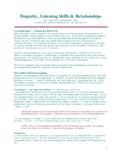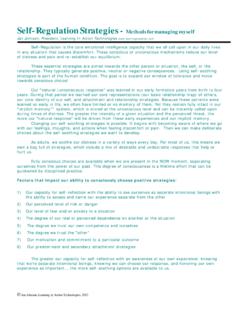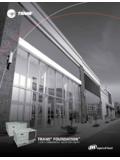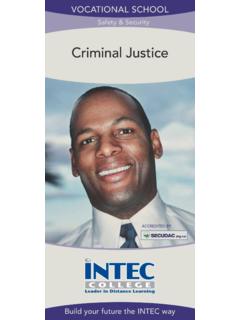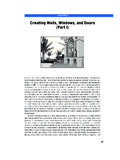Transcription of Building Resilient Organizations - Learning in Action
1 WEAREINthe most amazing period oftransformational change the world hasever seen. The business and social envi-ronment is complex, dynamic and turbulent,which means that today s success formula canbecome tomorrow s liability nearly or even surviving in this context requiresa fundamental re-thinking of the meaning andapplication of our most basic assumptions aboutleading, and managing, business growth and sur-vival. Our companies and Organizations mustbecome capable of living in a state of near-contin-uous flow. Every element of business must contin-uously change in response to ever-changingdemands. THE Resilient ORGANIZATIONI have developed a framework for under-standing and working with Organizations thataddresses this issue. The framework is a creativesynthesis of ideas and approaches drawn fromorganization psychodynamics and the new sci-ences, particularly the area of complex adaptivesystems.
2 Framework emphasis is on how todevelop what I call Resilient Organizations . I willshare this framework with you, some work I havedone with companies using it, and some ideasabout how you might use it in your own work. Let me start with a definition. A ResilientOrganizationis able to sustain competitiveadvantage over time through its capability to dotwo things simultaneously: deliver excellent performance against currentgoals. effectively innovate and adapt to rapid, turbulentchanges in markets and Resilient organization exhibits certainbroad characteristics. It is able to: createstructure, and to dissolveit; provide safety(not necessarily security or stabil-ity) in the midst of change; manage the emotional consequences of contin-uous transformation and change: anxiety andgrief; learn, develop and can such Organizations be built? A greatdeal of research has taken place over the last fif-teen years or so on complex adaptive systems , orlearning systems, which are able to successfullyadapt to changing environmental Learning systems are comprised of two inter-penetrating sub-systems with complementarydomains of activity.
3 The first of these subsystemsmight be called the Performance System,which isresponsible for performance of current goals andtasks in the interest of immediate survival. It isfocused on the first goal in the above definition. The complementary sub-system might becalled the Adaptation System, which is responsiblefor long-term sustainability via generation of alter-native paths, ideas, modes of operating and behav-ioral norms. It constantly generates possible futuresVOL. 32|NO. 3|200027 BuildingResilient OrganizationsBy Dean Robb The Resilient organization integrates the two domains by actively and consciously creating two subsystems: The Performance System and the Adaptation for the total system, in service of the second defi-nitional goal. Successful adaptive/ Learning systemsare characterized by robustness in both subsys-tems, and by strong linkages between them.
4 How-ever, in my work I have found that companiespresently tend to be overly adapted toward onedirection or the other. PERFORMANCE-DRIVEN ORGANIZATIONSP erformance-Driven Organizations are mostlya legacy of the Industrial Revolution and the his-tory of scientific management launched by Freder-ick Taylor (among others). They tend to be excel-lent at repetitive tasks, and delivering resultsagainst current goals. They aregenerally bureaucratic, and arebased on underlying assumptionsof task and environmental bureaucratic, political struc-tures serve to cope with anxietyand stress primarily by controllingit or suppressing it in the interestsof preserving order and the statusquo. The price is that they tend tohave great difficulty with innova-tion and EXAMPLE:APERFORMANCE-DRIVEN ORGANIZATIONI did some consulting workwith a long-standing telecommuni-cations company that had a set ofconcerns common to Perfor-mance-Driven Organizations .
5 Theirservice installation processes wereheavily documented and meas-ured, and deeply embedded intheir organizational structures, sys-tems and culture. Employees performing the workwere well trained and generally had been doingtheir jobs for a long time. The issue in this project was a lack of processflexibility, with an attendant difficulty in respond-ing to changing customer requirements. Adapta-tion, innovation and change were difficult proposi-tions indeed in this traditional, bureaucratic com-pany. Getting the changes implemented required asignificant change management track built into theproject, to build support, work organizational poli-tics, and deal with entrenched resistance at variousmanagement ORGANIZATIONSThe second type is what I call the Adaptation-Driven organization . Characteristically, this type isa start-up or relatively new, growing companyfocused around responsiveness, innovation, andchange.
6 Their processes and organizational struc-tures are fluid and dynamic. They are extremelyresponsive, but often have difficulties with incon-sistent performance, unstable processes, and creat-ing stable formulas for success. They can flounderon their difficulty in forming the structures nec-essary to deliver consistent, repeatable, EXAMPLE:AN ADAPTATION-DRIVEN ORGANIZATIONI consulted to a relatively new, fast-growinghigh tech company that provides integrated mes-saging services, which provide capability to sendand access voice messages, emails and faxesthrough a single access point via a telephone orcomputer. The company and its environment werecharacterized by rapid, dynamic change in productcapabilities, enabling technologies, markets, andcompetitors. This company was strongly the start of the project, new service instal-lation was a complex, dynamic project manage-ment exercise requiring the ability to deal withongoing changes in technologies, customerrequirements, and project scope throughout theduration of the project.
7 Process documentationwas scant or inadequate, and there was a heavyreliance on a small set of highly experienced proj-ect managers, continuous heroics, and a monu-mental effort at the very end to pull everythingtogether. Relationships among team members28 ODPRACTITIONERB uilding Resilient OrganizationsDEAN ROBB, MA, MSspent16 years in the corporateworld in quality managementand organizational effective-ness, instructional technology,training, marketing, and busi-ness research. For the pastseven years he has been anindependent consultant andhas helped companies in avariety of industries, nationallyand internationally, to improvebusiness operations and teamperformance, build more effec-tive, adaptable Organizations ,and manage change. Dean smasters degrees are in HumanDevelopment and Statistics. He is currently a doctoral can-didate at The Fielding become conflicted, and people were start-ing to feel burned out.
8 Customers did not feelentirely secure. The project focus was to rational-ize the process and make it more turnkey ,because the company desired to outsource instal-lation so they could focus more heavily on prod-uct innovation. THE Resilient organization :THE Building BLOCKSThe Resilient organization is a hybrid Resilient organization integrates the twodomains by actively and consciously creating twosubsystems: The Performance System and theAdaptation System, which are linked togetherthrough a foundation of:Each of these foundational elements has twocomplementary domains that correspond to thePerformance and Adaptation sides of theResilience equation. Let s look a bit more deeplyinto each of Resilient organization links together twoarchitectures, each of which is focused on one ofthe two complementary domains of activity.
9 ThePerformance System is comprised of those com-pany structures focused on current performance,which include: Effective, efficient business processes, tightlyaligned with customer needs Clear boundaries, goals and performance meas-ures for functions, teams and individuals Clear relationships between individuals, man-agers, teams and Organizations An effective performance management the perspective of the Resilient Organi-zation, these elements serve one purpose only:they are a temporarymeans of delivering value tocustomers, stockholders, employees, and perhapsthe surrounding community. They are not perma-nent aspects of the organization ; they must becontinually created, modified, dissolved and re-cre-ated. How does that happen? That is the functionof the Adaptation System Adaptation System s function is to gener-ate new life for the total organization .
10 It generatesnew solutions that must be integrated into the Per-formance System in order to meet emerging chal-lenges. This may require innovations in strategy,products and services, markets, processes, tech-nologies, stakeholder relationships, behaviors, cul-tural characteristics, leadership and managementstyles, organizational forms, or anything else thatwill contribute to the ability of the total organiza-tion to meet adaptive challenges. As such, itscharge is incredibly diverse, which is why it is diffi-cult to exhaustively characterize its exact of architectures include, but are not lim-ited to, structures such as: New business cells New product teams Process improvement and redesign teams Knowledge management architectures Learning organization architectures Strategy retreats Many large, long-standing companies utilizesome or all of these structures in their formal orga-nizational design and activities.
